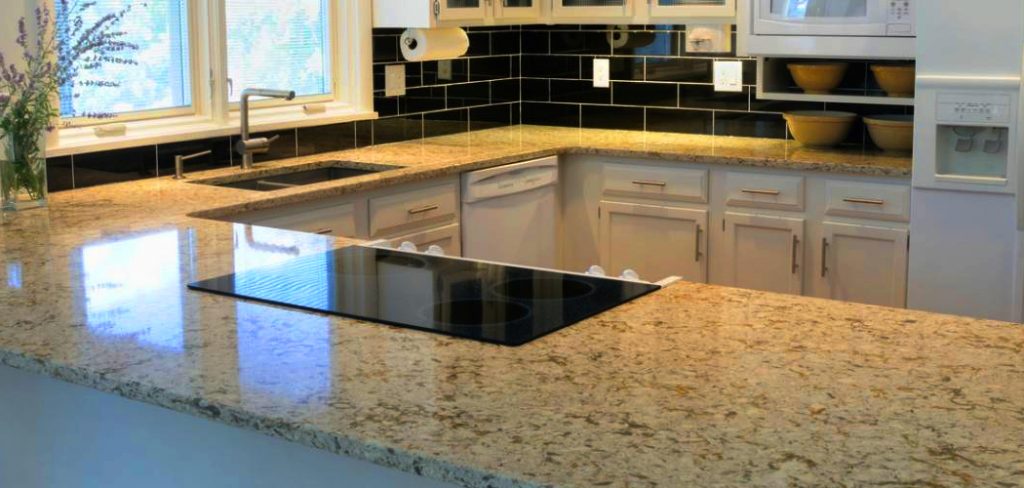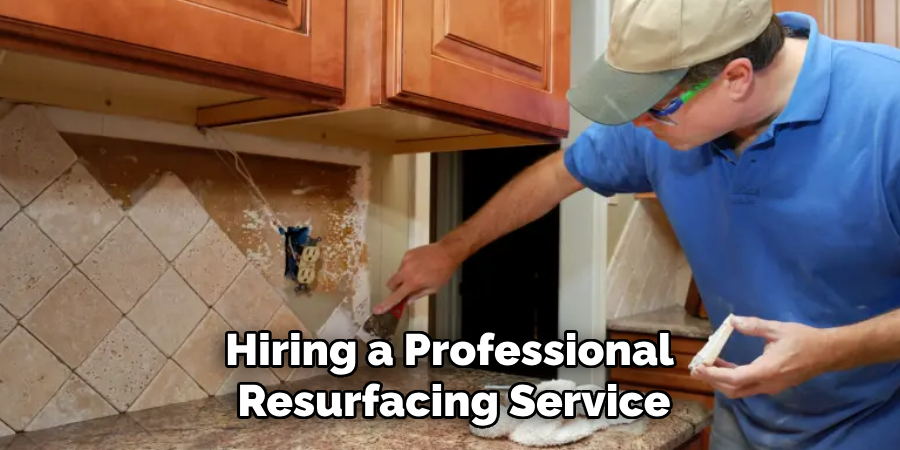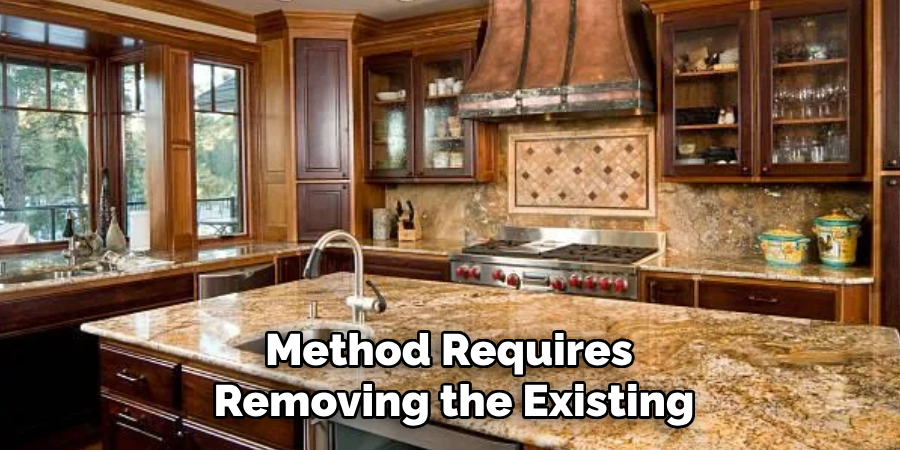Resurfacing Corian countertops is a cost-effective way to restore their appearance and ensure their longevity. Over time, these solid surface countertops can develop scratches, stains, or a dull finish due to regular use. Fortunately, with the right tools and techniques, you can rejuvenate your Corian countertops, making them look as good as new. This guide will walk you through the process of how to resurface corian countertops.

Signs It’s Time to Resurface
Knowing when to resurface your Corian countertops can help maintain their beauty and functionality. Here are some common signs that indicate it’s time for resurfacing:
- Visible Scratches or Cuts: Daily use, especially in high-traffic areas, can result in scratches or cuts on the surface, making the countertop look worn out.
- Stains That Won’t Wash Away: Stubborn stains from food, beverages, or cleaning agents may not be removable with routine cleaning, signaling a need for resurfacing.
- Dull or Faded Finish: Over time, Corian countertops can lose their original luster due to wear and tear. A cloudy or faded appearance is a clear sign.
- Rough Texture: If your countertop feels rough or uneven to the touch, it may need resurfacing to restore a smooth and uniform surface.
- Burn Marks: Heat damage from hot pans or appliances can leave burn marks, which are often fixable through resurfacing.
If you notice any of these issues, resurfacing can help bring your countertops back to their original condition.
The Benefits of Resurfacing Versus Replacing
When faced with damaged or worn Corian countertops, homeowners might wonder whether to resurface or replace them entirely. Resurfacing offers several distinct advantages over replacing, making it a preferred choice in many situations.
- Cost-Effective Solution: Resurfacing is significantly less expensive than replacing your countertops. It allows you to address the damage and restore the surface without investing in entirely new materials and labor.
- Time-Saving Process: Replacing countertops can be a lengthy process involving removal, disposal, and installation. Resurfacing, on the other hand, is quicker and can often be completed in a single day, minimizing disruption to your daily life.
- Eco-Friendly Option: By resurfacing rather than replacing, you’re reducing waste that would otherwise go to landfills. This sustainable approach helps extend the life of your countertops while reducing environmental impact.
- Preservation of Existing Design: If you appreciate the current layout or style of your countertops, resurfacing allows you to maintain the aesthetic while improving the surface condition. Replacing might involve finding a close match, which can be challenging.
- Customizable Finish: Resurfacing provides an opportunity to update the finish or sheen of your Corian countertops, giving them a refreshed appearance that fits your evolving taste or home décor.
Overall, resurfacing is a practical and efficient way to address wear and damage, offering both functional and financial benefits compared to a complete replacement.
10 Methods How to Resurface Corian Countertops
1. Cleaning and Polishing with a Buffer

The simplest method of resurfacing involves thorough cleaning and polishing. Begin by using a mild detergent and warm water to remove any dirt or grease. Once clean, dry the surface thoroughly. For deeper cleaning, you may want to use a non-abrasive cleaner, followed by a polishing compound. Using a buffer with a soft cloth attachment, work the compound into the surface in a circular motion. This process can help remove minor scratches and restore the shine of the Corian surface, making it look almost like new. However, this method is primarily effective for light surface damage.
2. Sanding the Surface
If the Corian countertop has deeper scratches or scuffs, sanding can be an effective method to resurface it. Start with a fine-grit sandpaper (around 220-grit) to lightly sand the surface. Be sure to sand in a circular motion and keep the sandpaper wet to prevent any dust from creating additional damage. Once the surface is even and the scratches have been removed, move to a finer grit, like 400-grit, to smooth the surface further. This method can help eliminate imperfections and restore a sleek, uniform appearance.
3. Using a DIY Refinishing Kit
There are several DIY Corian resurfacing kits available on the market that provide everything you need to restore your countertops. These kits typically include abrasive pads, sanding sponges, polishing compounds, and a guide on how to use the materials effectively. After preparing the countertop by cleaning it, you use the included sanding pads to gradually smooth out scratches, stains, and surface imperfections. These kits are an excellent choice for those who want a professional-grade finish without hiring a contractor.
4. Repairing Cracks and Chips

For Corian countertops with deep cracks or chips, these imperfections can be repaired before resurfacing. First, clean the affected area thoroughly. Then, use a Corian repair adhesive or filler that matches the color of your countertop. Apply the filler with a putty knife, making sure to smooth it out and fill the crack completely. Once the adhesive has cured, sand the area smooth and level it with the surrounding surface. After the crack or chip is repaired, you can proceed with polishing or sanding to make the repair less noticeable.
5. Using a Heat Gun for Minor Surface Blemishes
A heat gun can be used to treat minor burns or scorch marks on Corian countertops. Start by gently heating the damaged area with the heat gun, keeping it at a distance to avoid further damage. As the surface softens, use a spatula or another flat tool to smooth the area. Once the surface has cooled, sand it down to blend the repaired spot with the rest of the countertop. This technique can be especially helpful for small, isolated burns, making them nearly invisible.
6. Buffing and Sealing for a High Gloss Finish
To achieve a high gloss finish after resurfacing, buffing and sealing are crucial steps. Once you’ve sanded or polished your Corian countertop, you can use a polishing compound or a car wax to achieve a glossy, mirror-like finish. After buffing with a power sander or by hand, apply a protective sealant designed for use on Corian surfaces. The sealant will not only give your countertop a shiny appearance but also help protect it from future staining or damage. This method is perfect for those who want to restore their countertops to a luxurious, polished look.
7. Using a Professional Resurfacing Service

For more severe damage or if you want a flawless result, hiring a professional resurfacing service is an option. Professionals have access to specialized tools and equipment, such as industrial buffers and sanders, which can provide a smooth, even finish. They can also repair chips, cracks, and stains more effectively than a DIY method. This option tends to be more expensive but can save time and effort while ensuring a high-quality result.
8. Refinishing with a Corian-compatible Paint
Another method of resurfacing Corian countertops is using a Corian-compatible refinishing paint or coating. This process involves cleaning and lightly sanding the surface before applying a bonding primer designed for solid surfaces. Once the primer is dry, a layer of specialized countertop paint or epoxy is applied. After allowing it to cure, a finishing coat is added for extra durability and shine. While this method changes the appearance of the countertop (since it’s essentially painting over the existing surface), it’s a cost-effective solution for transforming your Corian countertops into a fresh look.
9. Resurfacing with a Quartz Overlay
If you’re looking to change the aesthetic of your Corian countertops without fully replacing them, a quartz overlay can be an excellent option. This method involves placing a thin layer of quartz over the existing Corian surface. The process requires a professional to take precise measurements and ensure proper adhesion. Once the quartz overlay is in place, the surface will look like a brand-new quartz countertop, with a durable, scratch-resistant finish that’s perfect for those seeking a high-end appearance without replacing the whole countertop.
10. Replacing the Surface Entirely

For countertops that are severely damaged beyond repair or for those who wish to upgrade to a different look, replacing the Corian surface may be the best option. This method requires removing the existing Corian countertop and installing a new one, either made of Corian again or another material like granite, marble, or quartz. Although this is the most expensive option, it offers the opportunity for a complete redesign and can add substantial value to your home.
Conclusion
Resurfacing Corian countertops can be an excellent way to refresh your kitchen or bathroom without the expense of a full replacement. Whether you choose to go the DIY route with sanding and polishing, or opt for professional services or a complete overlay, there are plenty of methods available to suit different needs and budgets. By following these steps, you can restore the beauty of your Corian countertops, making them look as good as new. Now that you know how to resurface corian countertops, try it yourself today and feel good about completing such a big DIY job!
Professional Focus
Angela Ervin, a former interior designer turned blogger, specializes in kitchen design and renovations. Through her website, she blends her passion for cooking with design expertise, sharing practical and creative ideas. Known for balancing functionality and beauty, Angela’s insightful content has made her a trusted voice in home design and lifestyle.
About the Author
Angela Ervin, an experienced interior designer and blogger, combines her passion for kitchen renovations with storytelling. Living in Petersburg with her family, she enjoys cooking and testing her projects firsthand. Known for her humor and relatable style, Angela shares creative, functional design insights through her content, making her a trusted voice in home design.
Education History
University: Virginia Commonwealth University
Degree: Bachelor of Fine Arts (BFA) in Interior Design
- Angela’s education at VCU focused on mastering core interior design principles, including spatial planning, color theory, materials selection, and sustainable design practices.
- She gained hands-on experience through studio projects and collaborative design exercises, which honed her ability to create functional and aesthetically pleasing environments.
- Her coursework also emphasized problem-solving and practical applications of design, preparing her for real-world projects like her self-directed kitchen renovations.
- The program’s strong foundation in both technical skills and creative expression shaped Angela’s ability to seamlessly integrate form and function in her work.
